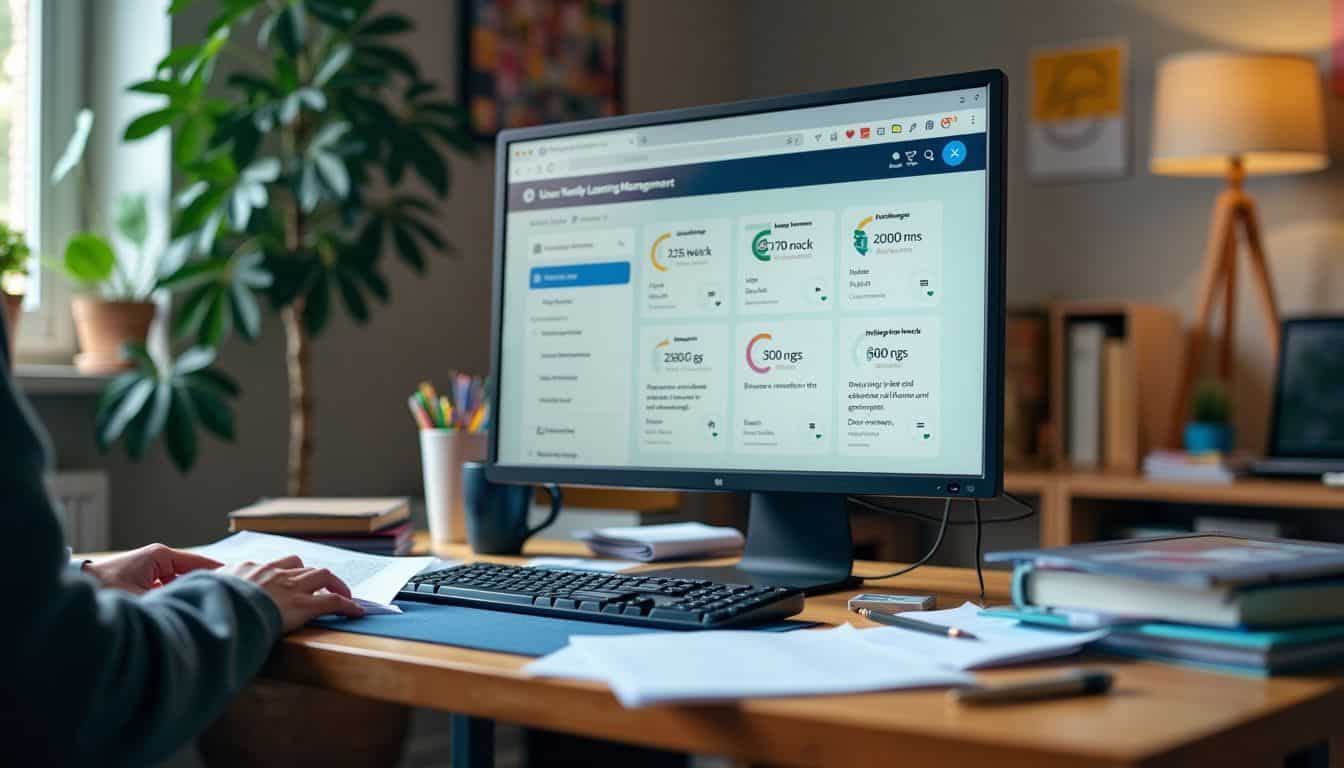Ever felt lost in the digital classroom maze? What is an LMS in education, anyway? It’s a fancy term for a tool that makes teaching and learning online a breeze. This post will unpack the mystery of Learning Management Systems and their must-have features.
Get ready for a tech-ed adventure!
Key Takeaways
LMS platforms are digital tools that help manage online learning, with the market expected to reach $36 billion by 2026.
Key LMS features include course management, user handling, assessment tools, and reporting capabilities.
LMS types include corpaorate vs. academic, cloud-based vs. on-premises, and free vs. paid options, each with distinct advantages.
Critical LMS features are SCORM compatibility, mobile accessibility, robust reporting tools, and strong security measures.
LMS implementation can reduce educational costs, improve learning experiences, and streamline administrative tasks, but may face challenges in system integration and user adoption.
Table of Contents
Exploring Learning Management Systems (LMS) in Education

Learning Management Systems (LMS) have become the backbone of modern education. These digital platforms help schools and colleges manage courses, track student progress, and deliver content online.
LMS software comes in many flavors, from free open-source options to paid cloud-based services. The LMS market is booming – experts predict it’ll hit $36 billion by 2026.
I’ve used several LMS platforms as both a student and teacher. They’re game-changers for online and blended learning. Good LMS tools let you easily create courses, give tests, and check grades.
Students can access materials 24/7 from any device. Some even have cool features like gamification to boost engagement. Today, a really old yet effective LMS is Trainual. However, newer alternatives like Paycom are gaining popularity. While the Paycom cost may be higher than some traditional options, it offers a comprehensive suite of HR and learning management tools that can benefit both educational institutions and businesses.
When picking an LMS, schools should think about their goals, budget, and tech needs.
Essential Functions of an LMS

Let’s dive into the heart of an LMS. These systems pack a punch with their core functions – they’re the real MVPs of online learning.
Managing Courses

Managing courses is a breeze with an LMS. It’s like having a digital classroom assistant that never sleeps. You can create, organize, and deliver online courses with ease. The system lets you upload various content types – videos, PDFs, quizzes – you name it.
It’s a one-stop shop for all your course materials.
But wait, there’s more! An LMS tracks learner progress and activities automatically. No more manual grade books or attendance sheets. It’s a time-saver that lets educators focus on teaching, not paperwork.
Plus, it offers tools for student engagement and collaboration. Think discussion forums, live chats, and group projects – all in one place.
An LMS is the Swiss Army knife of education – versatile, handy, and indispensable.
Handling Users and Groups

User groups in an LMS are like digital clubs. They let you sort folks based on teams, jobs, or where they work. This makes it easy to manage who sees what. You can set up auto-enrollment and send out alerts without breaking a sweat.
It’s like having a robot assistant for your online school!
But wait, there’s more! An LMS also lets you assign courses flexibly and pull reports quickly. You can give different people different roles, too. Some might be teachers, others students, and some could be admins.
Each role gets its own set of keys to the digital classroom. Next up, we’ll look at how an LMS handles tests and grades.
Conducting Tests and Assessments

Tests and assessments are the bread and butter of an LMS. They’re not just about grading – they’re tools to gauge learning progress and boost skills. A good LMS offers custom quizzes, exams, and projects.
It lets teachers create varied question types, from multiple-choice to open-ended. Plus, it handles the grunt work with automated grading and instant feedback.
But wait, there’s more! Modern LMS platforms spice things up with gamification. They turn boring tests into engaging challenges. Students earn points, badges, or climb leaderboards as they learn.
This makes studying feel less like a chore and more like a game. For teachers, built-in reports and dashboards offer a bird’s-eye view of class performance. They can spot trends and help students smarter in class.
Next up, let’s dive into the different types of Learning Management Systems out there.
Categories of Learning Management Systems

LMS types come in all shapes and sizes – from corporate to academic, cloud-based to on-premises, and free to paid… Want to know which one’s right for you? Keep reading!
Comparing Corporate and Academic LMS
Corporate and academic LMS platforms serve different needs. Let’s break down their key differences:
| Feature | Corporate LMS | Academic LMS |
|---|---|---|
| Update Frequency | Often updated | Less frequent updates |
| Main Focus | Employee training, customer education | K-12, higher ed, professional development |
| Key Features | Performance reporting, eCommerce integration | Lesson formats, discussion forums, grading systems |
| Customization | White-labeling options | Limited branding choices |
| Integration | More integration capabilities | Fewer integration options |
Corporate LMS platforms pack a punch with frequent updates. They’re built for business needs. Think employee training and keeping customers in the loop. On the flip side, academic LMS platforms take it easy on updates. They’re all about schools and colleges.
Here’s the kicker: corporate LMS comes with cool stuff like performance tracking and online stores. Academic LMS? It’s got lesson plans, chat rooms, and grade books. It’s like comparing apples and oranges!
Want to make your LMS look like your brand? Corporate LMS has you covered with white-label options. Academic LMS? Not so much. It’s pretty basic in the looks department.
Last but not least, corporate LMS plays well with others. It connects to tons of other tools. Academic LMS? It’s a bit of a lone wolf. Fewer connections, but it gets the job done for schools.
Cloud-Based LMS versus On-Premises Solutions
Moving from corporate and academic LMS, let’s explore the differences between cloud-based and on-premises solutions. These two options offer distinct advantages for educational institutions.
| Cloud-Based LMS | On-Premises LMS |
|---|---|
• Accessed via internet • No hardware needed • Quick setup • Regular auto-updates • Pay-as-you-go model • Great for remote learning | • Installed locally • Needs dedicated hardware • Longer setup time • Manual updates • One-time license fee • Better for strict data rules |
• Less control over data • Depends on internet connection • Lower upfront costs • Easier to scale | • Full control over data • Works without internet • Higher upfront costs • Harder to scale |
Cloud-based LMS solutions are gaining popularity. They’re flexible, cost-effective, and easy to access from anywhere. No need for fancy tech gear or IT wizards on staff. Just log in and start learning!
On-premises LMS, on the other hand, is like having your own fort. You call the shots on everything. It’s great for schools with strict data rules or unique needs. But it comes with a price – literally and figuratively.
Some schools are trying a mix of both. It’s like having your cake and eating it too. They get the best of both worlds – the freedom of the cloud with the security of on-site systems.
In the end, the choice depends on your school’s needs, budget, and tech-savvy. Cloud or on-premises? It’s not just about where your data lives. It’s about how you want to shape the future of learning.
Options Between Free and Paid LMS
Free or paid? That’s the big question when choosing an LMS. Let’s break it down for you tech-savvy folks.
| Free LMS | Paid LMS |
|---|---|
• Open-source options like Moodle • No upfront costs • Basic features • Limited support • DIY installation and maintenance • Examples: GoSkills, TalentLMS, Thinkific | • Commercial platforms • Subscription or licensing fees • Advanced features • Dedicated support • Managed hosting and updates • Examples: Mindflash, Litmos, Cornerstone LMS |
| Key Differences: • Scalability: Paid options often handle larger user bases • Customization: Enterprise LMS offer more personalization options • Integration: Paid systems typically connect better with other tools • Cost: Self-hosted platforms can run around $25,000 | |
I’ve used both types in my career. Free LMS are great for small teams or startups. But as you grow, paid options become more attractive. They save time and headaches… trust me on that!
“Free” isn’t always free. You might spend hours fixing bugs or adding features. On the flip side, paid LMS can be overkill for simple needs. It’s all about finding that sweet spot for your specific situation.
Critical Features in Learning Management Systems

Let’s dive into the must-have features of a top-notch LMS. These key elements can make or break your online learning experience – so pay attention!
Compatibility with SCORM Standards
SCORM standards are the backbone of modern e-learning. They make sure online courses work smoothly across different systems. Picture a universal language for digital learning content.
That’s SCORM. It lets you create a course once and use it anywhere. Cool, right?
SCORM comes in three flavors: 1.2, 2004, and its variants. Each version ups the game in content packaging and LMS communication. Tools like Rustici Driver help achieve SCORM conformance.
This means your courses can hop from one platform to another without a hitch. It’s like having a skeleton key for all learning platforms.
SCORM is the Swiss Army knife of e-learning standards.
Next up, we’ll dive into how mobile devices are changing the LMS game.
Accessibility on Mobile Devices
Moving from SCORM standards, let’s talk about another key feature: mobile access. In today’s fast-paced world, learners need to study on the go. That’s where mobile-friendly LMS comes in handy.
A good LMS works well on phones and tablets. It lets students learn anytime, anywhere. The design should fit different screen sizes. This means easy reading and navigation on any device.
Many LMS platforms now offer apps for iOS and Android. These apps make it simple to download lessons, take quizzes, and chat with classmates. With mobile access, learning becomes more flexible and fun.
Students can squeeze in study time during their commute or lunch break. It’s a game-changer for busy folks who want to keep learning.
Tools for Reporting and Analysis
LMS reporting tools are like x-ray vision for your learning program. They let you peek inside student progress, test scores, and survey answers. Cool dashboards show you the big picture at a glance.
You can spot who’s crushing it and who’s falling behind. These tools crunch numbers to find patterns and suggest custom learning paths for each student.
Data nerds, rejoice! LMS analytics track how well your training works and prove its value. You’ll see which courses rock and which flop. Plus, you can measure student engagement – who’s logging in and who’s ghosting class.
With these insights, you can tweak your content to keep learners hooked and boost their success.
Security Features and User Permissions
Security is the backbone of any good LMS. It’s not just about keeping data safe – it’s about trust. Strong user authentication and data encryption are must-haves. Multi-factor authentication (MFA) and Single Sign-On (SSO) add extra layers of protection.
But here’s the kicker: insider threats jumped 44% in 2022. Yikes!
Let’s talk numbers. Security slip-ups can cost a whopping $15.38 million per incident. That’s why LMS platforms need nine key security features, including SSL, two-step checks, and tough password rules.
Regular security checks and user training are crucial too. It’s all about staying one step ahead of the bad guys. Now, let’s explore how an LMS can simplify administrative tasks and boost learning experiences.
Advantages of Implementing an LMS

LMS tools can make teaching a breeze – saving time, boosting learning, and cutting costs. Want to know more? Keep reading!
Simplifying Administrative Processes
LMS platforms are a game-changer for admin tasks. They cut through the red tape, making life easier for educators and staff. Gone are the days of drowning in paperwork and endless spreadsheets.
These smart systems handle course updates, student records, and grading with a few clicks. It’s like having a super-efficient assistant who never sleeps!
But wait, there’s more! LMS tools shine in data tracking and reporting. They crunch numbers faster than you can say “pop quiz,” giving quick insights into student progress. This means less time number-crunching and more time focusing on what really matters – teaching.
Plus, it’s a breeze to onboard new students or update course materials. No more copy-paste marathons or email avalanches. Just upload once, and you’re good to go!
Improving the Learning Experience
LMSs boost learning in cool ways. They make lessons fun and easy to get. You can watch videos, play games, and chat with classmates online. This keeps you hooked and helps you learn better.
Plus, you can study at your own pace. No more boring lectures!
These systems track how you’re doing too. They show what you’re good at and where you need help. Teachers can then give you just the right stuff to learn. It’s like having a personal tutor…
but way cheaper! Next up, let’s talk about how LMSs help schools save money.
Adapting to Various Educational Needs
LMS platforms excel at meeting diverse learning needs. They provide tools for different learning styles, paces, and preferences. Visual learners? No problem. Audio fans? Covered. Hands-on folks? Check.
These systems allow teachers to create custom paths for each student. It’s like having a multi-tool for education.
I’ve seen firsthand how LMS flexibility works wonders. In my class, I had students from various backgrounds. Some struggled with English, others with math. The LMS allowed me to assign specific content to each group.
Result? Everyone improved at their own speed. It’s great to see tech bridging learning gaps so effectively.
Reducing Educational Costs
LMS tools can slash training costs big time. They cut down on travel expenses by offering online classes. No more flying folks around for workshops! Plus, these systems store all learning stuff in one spot.
This means no printing costs for bulky manuals or handouts. It’s all digital, baby!
But wait, there’s more! Mobile-ready LMS lets people learn on their own devices. No need to buy fancy equipment. Employees can train on their phones or tablets during downtime. This boosts productivity and saves cash.
It’s a win-win for both learners and the company’s bottom line.
Overcoming Challenges with LMS Implementation

Implementing an LMS can be tricky – like trying to fit a square peg in a round hole. But don’t sweat it! With the right game plan, you can dodge common pitfalls and get your new system up and running smoothly.
Integrating with Current Systems
Integrating an LMS with existing systems can be a real headache. Tech geeks know the struggle – compatibility issues pop up like whack-a-mole. But don’t sweat it! APIs are your secret weapon.
They bridge the gap between old and new, making systems play nice together. It’s like teaching old computers in schools new tricks.
Data security is another big deal when merging systems. You’ve got to lock that info down tight. Strong encryption is key – it’s like putting your data in Fort Knox. And hey, don’t forget about the humans! People can be resistant to change.
The fix? Train ’em up! Give users a crash course in the new system. It’s like teaching a cat to swim… tricky, but doable with patience and treats.
Encouraging User Adoption and Training
After sorting out system integration, the next hurdle is getting people on board. User adoption can make or break an LMS rollout. It’s not enough to just set up the system and hope for the best.
You’ve got to get folks excited about using it.
One way to boost adoption is through internal marketing. Spread the word about how cool the new LMS is. Show off its best features. Maybe even throw in some incentives for completing courses.
It’s also key to have the right people running the show. Experienced admins can assign roles smartly, keeping things running smooth. And don’t forget about the content itself. Make it fun and packed with multimedia.
Boring stuff won’t cut it. Lastly, keep an eye on those data points. Tracking progress helps measure success and keeps users engaged. With these tips, you’ll be well on your way to LMS adoption success.
Addressing Data Security Issues
Data security in LMS platforms is a big deal. Insider threats jumped 44% in 2022, making things tricky. But don’t sweat it – there are ways to lock down your learning data. Start with the basics: SSL encryption, two-step logins, and tough password rules.
Then, keep an eye on things with audit logs. Regular security checks help spot weak spots before the bad guys do. And don’t forget about user privacy and access control – they’re key to keeping data safe.
The price tag for security slip-ups? A whopping $15.38 million per incident. Ouch! That’s why it’s smart to define what needs protecting, run frequent audits, and assess risks. Solid security isn’t just about tech – it’s also about people.
Train your team on best practices. Use data encryption to keep prying eyes away. And always stay on top of compliance rules. It’s a lot to juggle, but it beats dealing with a costly breach.
Selecting the Appropriate LMS

Picking the right LMS is like finding a perfect pair of shoes – it’s gotta fit just right! Want to know how to snag the best one for your needs? Keep reading…
Defining Educational Goals and Objectives
Setting clear goals is key in education. An LMS helps teachers and students get on the same page fast. It’s like a roadmap for learning. With an LMS, you can track how students are doing and spot areas where they need help.
This data is gold for teachers – it shows what’s working and what’s not.
LMS tools are great for finding skill gaps too. They let you match what you’re teaching to what students really need. Whether you’re in a school or a company, picking the right LMS matters.
Some are built for classrooms, others for job training. Cloud-based ones let you learn anywhere, while others stay put on school computers. The cool part? An LMS helps measure how well your training works.
It’s like having a report card for your teaching methods. Next up, let’s look at how to pick the best LMS for your needs.
Assessing Audience Needs
After setting clear goals, it’s time to focus on your audience. Understanding who you’re teaching is essential for selecting the right LMS. You need to understand their learning preferences and styles.
Start by asking some questions. What are your learners’ tech skills? Do they prefer videos or reading? Can they access the LMS on their phones? These answers will guide your choice.
Keep checking in with your audience regularly. Their needs might change, and your LMS should adapt. Regular surveys and feedback sessions can help you stay on track. A good LMS should fit your learners perfectly – not the other way around.
Balancing Features Against Budget
Moving from audience needs to budget concerns, let’s talk money. Picking an LMS is like shopping for a car. You want all the cool gadgets, but your wallet might disagree. It’s a balancing act.
First, figure out what features you really need. Don’t get swayed by shiny extras that’ll gather digital dust. Look at your must-haves and nice-to-haves. Then, check your bank account.
Some LMS providers offer tiered pricing. This means you can start small and add features as you grow. Also, don’t forget about hidden costs like training and support. These can sneak up on you like a ninja in the night.
Lastly, think long-term. A cheap option now might cost more later if you outgrow it fast. So, pick wisely – your future self will thank you!
Review of Popular LMS Platforms in Education

Let’s dive into some popular LMS platforms in education. These big players have shaped online learning – and they’re worth a closer look.
Moodle Insights
Moodle rocks the e-learning world with its cool features. It’s been around for over 20 years, making it a seasoned pro in educational tech. This platform isn’t just another run-of-the-mill tool – it’s a powerhouse.
It offers learning analytics, mobile access, and automated alerts. Plus, it plays nice with other educational tools like video chats and plagiarism checkers.
Want to set up your own massive open online course? Moodle’s got you covered. You can use MoodleCloud, self-host it, or team up with Moodle Certified Partners. It’s like a Swiss Army knife for online learning – versatile and ready for action.
Whether you’re a tech whiz or a newbie, Moodle’s user-friendly interface makes creating engaging online courses a breeze.
Features of Blackboard Learn
Moving from Moodle, let’s explore Blackboard Learn. This popular platform packs a punch for online learning. Developed by Anthology, Inc., it serves both schools and companies.
Blackboard Learn offers flexibility. You can use it in the cloud or on your own servers. It shines in course delivery, testing, and teamwork tools. The platform also gives you solid analytics and works great on phones.
It covers 92.3% of virtual classroom needs. But it’s not perfect. Its online course sales features are a bit weak, hitting only 66% of core functions. Still, users seem happy. They rate it 3.9 out of 5 based on 281 reviews.
Overview of Canvas by Instructure
Canvas by Instructure is a powerhouse in the online learning world. It’s more than just another LMS – it’s a full set of tools that make teaching and learning easy. Think about it: you’ve got course creation tools, analytics, and even custom learning paths all in one place.
Pretty sweet, right? And here’s the best part – you can access it all on your phone with their mobile apps. No more being stuck at your desk!
But that’s not all! Canvas has six different user roles, from admins to observers. This means everyone gets just the right level of access. Oh, and for all you budget-conscious educators out there – they’ve got a free version called “Free-for-Teacher”.
It’s like they’re practically giving away knowledge! Now, let’s look at some popular LMS platforms that are changing the education scene.
People Also Ask
What’s an LMS and why should schools care?
An LMS, or learning management system, is like a digital Swiss Army knife for education. It’s a software that helps manage online training, virtual classrooms, and e-learning courses. Schools love it because it makes life easier for teachers and students alike.
How does an LMS shake up traditional classroom-based education?
Picture this: a flipped classroom where students learn at home and practice in class. That’s what an LMS can do. It mixes things up, turning education on its head. Students can access course materials anytime, anywhere. It’s like having a teacher in your pocket!
Can an LMS handle both online and in-person learning?
You bet! An LMS is flexible as a gymnast. It can juggle online education, distance learning, and good old-fashioned face-to-face instruction. It’s perfect for schools that want the best of both worlds.
What are some cool features of a modern LMS?
Modern LMSs are packed with goodies. They offer mobile learning, social features for collaborative learning, and even gamified elements to boost engagement. Some even have tools for webinars and virtual classrooms. It’s like an educational playground!
Is an LMS only for schools, or can businesses use it too?
An LMS isn’t just for ABCs and 123s. Businesses love them for corporate training and compliance courses. They’re great for getting new hires up to speed or teaching old dogs new tricks. It’s a jack-of-all-trades in the learning world.
How does an LMS track student progress?
LMSs are like hawk-eyed teachers. They keep tabs on student performance, track completion rates, and even measure learner engagement. They crunch numbers faster than you can say “pop quiz” and give insights that help improve the learning process. It’s like having a crystal ball for education!
References
https://education.adaptit.tech/blog/key-features-of-learning-management-system/
https://www.learnupon.com/blog/lms-features-overview/
https://technologyadvice.com/blog/human-resources/important-learning-management-system-lms-features/ (2023-07-18)
https://www.ncbi.nlm.nih.gov/pmc/articles/PMC9255472/
https://solutions.trustradius.com/buyer-blog/corporate-vs-academic-lms/ (2021-09-10)
https://programminginsider.com/comparing-cloud-based-vs-on-premises-lms-solutions/ (2024-09-18)
https://scorm.com/scorm-explained/
https://www.reworked.co/digital-workplace/what-is-a-learning-management-system/
https://www.powerschool.com/blog/learning-management-system/
https://freshlearn.com/blog/lms-in-education/ (2023-02-21)
https://wahoolearning.com/blog/learning-management-systems/benefits-customised-lms/ (2023-01-23)
https://research.com/education/what-is-lms
https://www.gyrus.com/blogs/lms-integration-challenges-and-solutions
https://wahoolearning.com/blog/learning-management-systems/the-9-challenges-of-managing-an-lms/
https://www.gyrus.com/blogs/lms-security-and-compliance (2024-07-25)
https://www.techtarget.com/searchcio/definition/learning-management-system
https://www.skillscaravan.com/post/how-to-choose-the-right-learning-management-system-lms (2024-08-16)
https://skillq.com/lms-features-overview/ (2024-04-16)
https://www.ispringsolutions.com/blog/how-to-choose-an-lms (2024-07-25)
https://moodle.com/solutions/lms/
https://www3.technologyevaluation.com/selection-tools/features-list/31884/blackboard-learn
https://community.canvaslms.com/t5/Canvas-Basics-Guide/What-is-Canvas/ta-p/45
